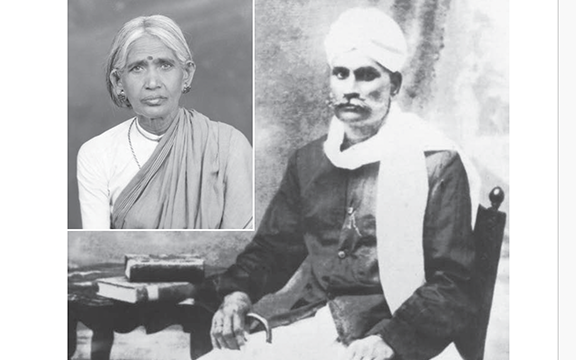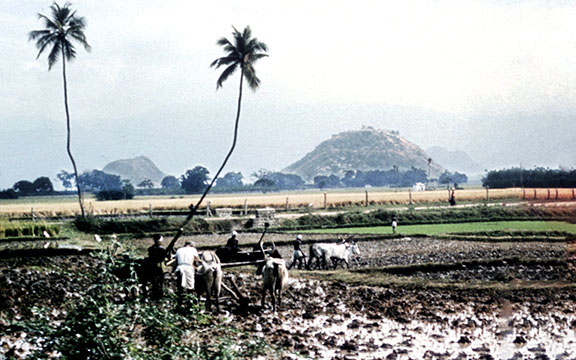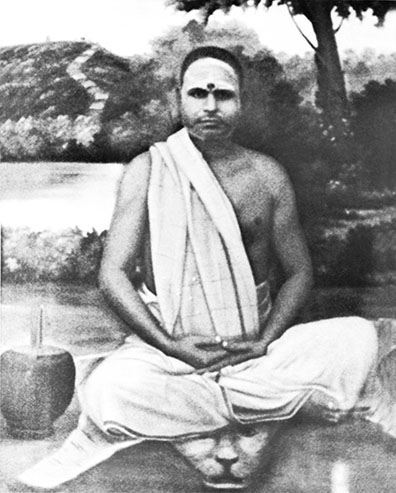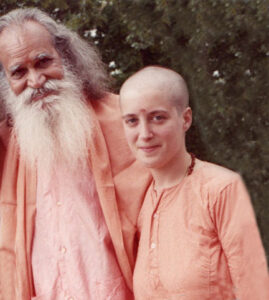
Photo: A portion of the family farmland in Chettipalayam, South India, early 1980s.
In the South Indian state of Tamil Nadu, with its verdant landscapes nestled amid swaying coconut palms and fragrant jasmine vines, lies a quaint village steeped in timeless charm and rustic allure. This is the setting in which the family home of Sri Gurudev Swami Satchidananda was situated—in the small village of Chettipalayam, which lies well outside of the city of Kovai (Coimbatore), in Tamil Nadu, the southernmost state in India.
Sri Kalyanasundaram, the father of Sri Gurudev Swami Satchidananda (then called Ramaswamy, or Ramu for short) was the unofficial chief of the village. A poet himself, Sri Kalyanasundaram let the house serve as the meeting hall for poets, musicians, philosophers, and jyotishis (Vedic astrologers). Sadhus and sannyasis, wandering ascetics and holy men passing through the area, were directed to this family home for free food and lodging. The family served these guests directly, rather than giving the job to the household staff. Srimati Velammai (Sri Gurudev’s mother) made sure every guest felt welcome and honored.
The teaching “Atithi Devo Bhava,” which translates to “The guest is God,” is deeply rooted in Indian culture and hospitality. Its origins can be traced back to ancient Indian scriptures, particularly the Vedas and the Upanishads, which emphasize the importance of hospitality and respect for guests. Hospitality is considered a sacred duty and virtue (dharma), reflecting the principle of universal love and compassion (karuna). The belief in the divinity of guests stems from the idea that all beings are manifestations of the Divine, and therefore, treating guests with reverence and kindness is akin to serving God.
In describing Sri Gurudev’s parents, Sri Krishnaswamy Gounder said, “My brother-in-law, Sri Kalyanasundaram, was very advanced spiritually. He was a saintly man, a Tamil scholar, and a widely acclaimed poet. My sister, Srimati Velammai, was quiet and good-natured. She was endowed with all of the finest qualities. Only such a woman could bring forth someone of the stature of Swami Satchidananda.”

Photo: Sri Gurudev’s revered parents.
Srimati Velammai was inspired by the holy men who spent time in their home and decided that her next child should be this type of person. He should be one with the qualities of wisdom, service to all, detachment and love, as shown by the swamis her family served. She and her husband traveled sixty miles to Palani, the holy hill shrine of Lord Muruga, to the ashram of Sri Sadhu Swamigal, the family Guru, to seek his guidance.
Tamil Shaivism & Palani Malai
Sri Gurudev’s parents were both deeply devout practitioners of Tamil Shaivism, which developed alongside the broader Shaivite (worship of Lord Siva) tradition within Hinduism. The Sangam (Tamil) literature comprises ancient Tamil texts dating from the 3rd century BCE to the 3rd century CE. The Nayanars, who were Tamil poet-saints, played a significant role in shaping the devotional and philosophical aspects of Tamil Shaivism during the 6th to 9th centuries CE. Their hymns, known as the Tevaram, are revered as sacred scriptures and form the foundation of the Shaiva Siddhanta philosophical tradition. The stories of the Nayanars’ lives and poetry filled Sri Gurudev’s childhood home and he was immersed in the inspiration flowing from them.
Nestled amidst the greenery and rolling hills of Tamil Nadu in South India lies the holy town of Palani, a place steeped in spirituality and ancient tradition. Palani is renowned for its hill temple, the millenia-old Arulmigu Shri Dhandayuthapani, one of the six abodes of Lord Muruga. Lord Muruga (also called Karthikeyan, Skanda, Kumara, Subramanya, among other names), the son of Lord Shiva and Goddess Parvathi and brother to Lord Ganesh, is particularly popular and predominantly worshipped in Tamil Nadu. The family deity in Sri Gurudev’s childhood home was Lord Muruga and the family had deep ties to his worship as recounted in part 1 of this spiritual odyssey we are undertaking. Family relatives established the Kaumara Madalayam (a spiritual center and temple for the devotees of Lord Muruga) near Coimbatore, South India in the early 20th century and the Ashram of the family Guru was located just at the foot of the Muruga Temple in Palani.

Photo: En route to Palani. Temple hill visible at a distance on the right.
In the 1900s, the journey to this temple began with a climb up the steep steps of the hill, a symbolic ascent toward spiritual enlightenment. Pilgrims undertake this arduous trek with unwavering devotion, chanting hymns and prayers to Lord Muruga. At that time, Palani had become a place of convergence of souls unfolding like petals unfurling under the benevolent gaze of the Divine. The area emerged as a celestial haven, a sacred crossroads of spirituality, for Siddhars, Vaidyars (those who heal), sadhus and yogis. It was known as “Siddhar Malai,” the mountain of Siddhars. In the Tamil Shaiva Tantra tradition, Siddhars are considered adepts with mystical powers and some were said to have lived for thousands of years.
Shaiva Tantra and Sri Sadhu Swamigal
Over the centuries, Tamil Shaivism continued to evolve and flourish, influenced by various religious and cultural developments in South India. It absorbed elements of bhakti (devotional) movements and Shaiva Shakti Tantra, contributing to its rich and spiritual landscape. Sri Sadhu Swamigal was a great bhakta and Siddhar. Tamil Shaiva Shakta Tantra is the southern stream of Tantra (5th century) that emerged in the southern region of India, while the northern stream is most often referred to as “Kashmiri Saivism.” The neo-tantra movement that arose in the West in the late 20th century has little in common with the ancient classical northern and southern streams of Shaiva Shakta Tantra.
Shaiva Shakta Tantra integrates elements of Shaivism and Shaktism, two major Hindu traditions that venerate Lord Shiva and the Goddess Shakti, respectively. It emphasizes the worship of Shiva (the masculine aspect) and Shakti (the feminine aspect) as one indivisible ultimate Reality. Rooted in philosophical tradition, Tantra posits that the entire universe, including the individual self (jiva) and the divine reality (Brahman), is ultimately of the same essence and devoid of any inherent duality. This is why it is considered Paramādvaya, the highest nondual teaching because it simultaneously encompasses and subsumes both dualism and nondualism. How? As Dr. Christopher Hareesh Wallis, a scholar of the tradition explains, “It is the inexpressible experience of the totality of reality in which no perspective is excluded, for each is seen as fitting into the pattern of a greater whole. In the Tantra system, our experience of duality is undeniably real but not considered the deepest fundamental reality.” One can think of this in terms of a wave, which appears to have its own identity, yet it cannot be removed from the ocean because ultimately and essentially it is the very same water as the ocean. Likewise, Tantra posits that the dualities we experience (the “10,000 things”) are essentially appearances of the One Infinite Consciousness. The spiritual goal is to recognize the essential unity within everything while enjoying the diversity. This understanding is foundational to Sri Gurudev’s Integral Yoga teachings.

Photo: Sri Sadhu Swamigal
Sri Sadhu Swamigal, whose name translates to “ascetic saint,” was a luminous figure in the spiritual landscape of Tamil Nadu. He came from Achalpuram on the banks of Kollidam. We know very little else about his early life or spiritual quest. Guided by divine grace, he attained mastery over the esoteric sciences of Yoga, meditation, and alchemy, unlocking the secrets of the universe. Sri Swamigal was devoted to Shakti, particularly in the form of Sri Raja Rajesvari, a form of Sri Lalita Tripurasundari. Sri Lalita Tripurasundari embodies the qualities of beauty, grace, and auspiciousness, and is revered as the Divine Mother who bestows blessings, protection, and spiritual liberation upon her devotees. Next to the Ashram, was a temple to this Goddess where Swamigal performed worship.
In the ashram itself, there was daily worship of the Sri Chakra, also known as Sri Yantra. In the mystical realm of Hindu spirituality, the worship of the Sri Chakra holds a revered place as a profound and potent means of invoking the Divine Presence and energies. It has a central place in the worship of Goddess Sri Lalita Tripurasundari. It is said that this Yantra originated from Lord Siva Himself. In the classical Tantra traditions, the Sri Chakra represents the cosmic blueprint of creation, the supreme embodiment of feminine energy, and radiates protective energies. Each component of the Sri Chakra, from the outermost perimeter to the central bindu, contains various aspects of the cosmos, chakras, the divine feminine principle, and numerous deities. It is also said to offer adepts mystical powers.
Sri Sadhu Swamigal also engaged in the worship of another form of Shakti (Parvathi), Goddess Annapoorna. Anna means “food” and poorna means “fullness.” She is the Goddess of food and its abundance. Daily, the ashram free meals to the thousands of sadhus who came to Palani and continues to do so. It was here in Palani, that Srimati Velammai and her husband traveled to Swamigal’s ashram so she could request her Guru, to bless her to conceive a highly spiritual child who would become a great spiritual light to the world. Swamigal gave her a mantra to invoke the Divine Light. She repeated it constantly, developing within a vibration conducive to receiving the type of soul she desired.
Their second son, named Ramaswamy, was born on the twenty-second of December, 1914. The Hindus say that one year in human life is one day in the life of the devas (gods). Each month is a portion of their day. Of the months, the most auspicious is Margali, the period from the fifteenth of December until the fifteenth of January. To the gods this is brahmamurta, the hours just before dawn, which are most favorable for meditation. So Margali is a very special, holy time; all during that month the devas are in meditation. While they were in meditation, Ramaswamy was born—during the “Dawn of the Devas.”
In upcoming installments, we will revisit Palani, Sri Sadhu Swamigal, and the great Siddhar Bhogar, all who will play a pivotal role in the life of Swami Satchidananda and the Integral Yoga Tradition.
Find previous installment here: Part 1
About the Author:
 Swami Premananda, Ph.D. is a senior disciple of Sri Gurudev Swami Satchidananda and served as his personal and traveling assistant for 24 years. Her interest in the study of the spiritual roots of the Integral Yoga tradition and lineage was inspired over many years of traveling with Sri Gurudev to the various sacred sites throughout India that are a part of this tradition. She also undertook a 2-year immersion into the nondual Saiva Yoga Siddhar tradition that is at the heart of Sri Gurudev’s spiritual roots. She further studied the history, sacred texts, and teachings of Tamil Saivism including the Siddhars, bhakti poet saints, as well as the spiritual luminaries who lived in the 19th – 20th centuries and who inspired Sri Gurudev, such as Sri Ramana Maharshi, Swami Ramdas, and Swami Vivekananda. She serves as editor of Integral Yoga Magazine, Integral Yoga Publications; senior archivist for Integral Yoga Archives; and director of the Office of Sri Gurudev and His Legacy.
Swami Premananda, Ph.D. is a senior disciple of Sri Gurudev Swami Satchidananda and served as his personal and traveling assistant for 24 years. Her interest in the study of the spiritual roots of the Integral Yoga tradition and lineage was inspired over many years of traveling with Sri Gurudev to the various sacred sites throughout India that are a part of this tradition. She also undertook a 2-year immersion into the nondual Saiva Yoga Siddhar tradition that is at the heart of Sri Gurudev’s spiritual roots. She further studied the history, sacred texts, and teachings of Tamil Saivism including the Siddhars, bhakti poet saints, as well as the spiritual luminaries who lived in the 19th – 20th centuries and who inspired Sri Gurudev, such as Sri Ramana Maharshi, Swami Ramdas, and Swami Vivekananda. She serves as editor of Integral Yoga Magazine, Integral Yoga Publications; senior archivist for Integral Yoga Archives; and director of the Office of Sri Gurudev and His Legacy.

